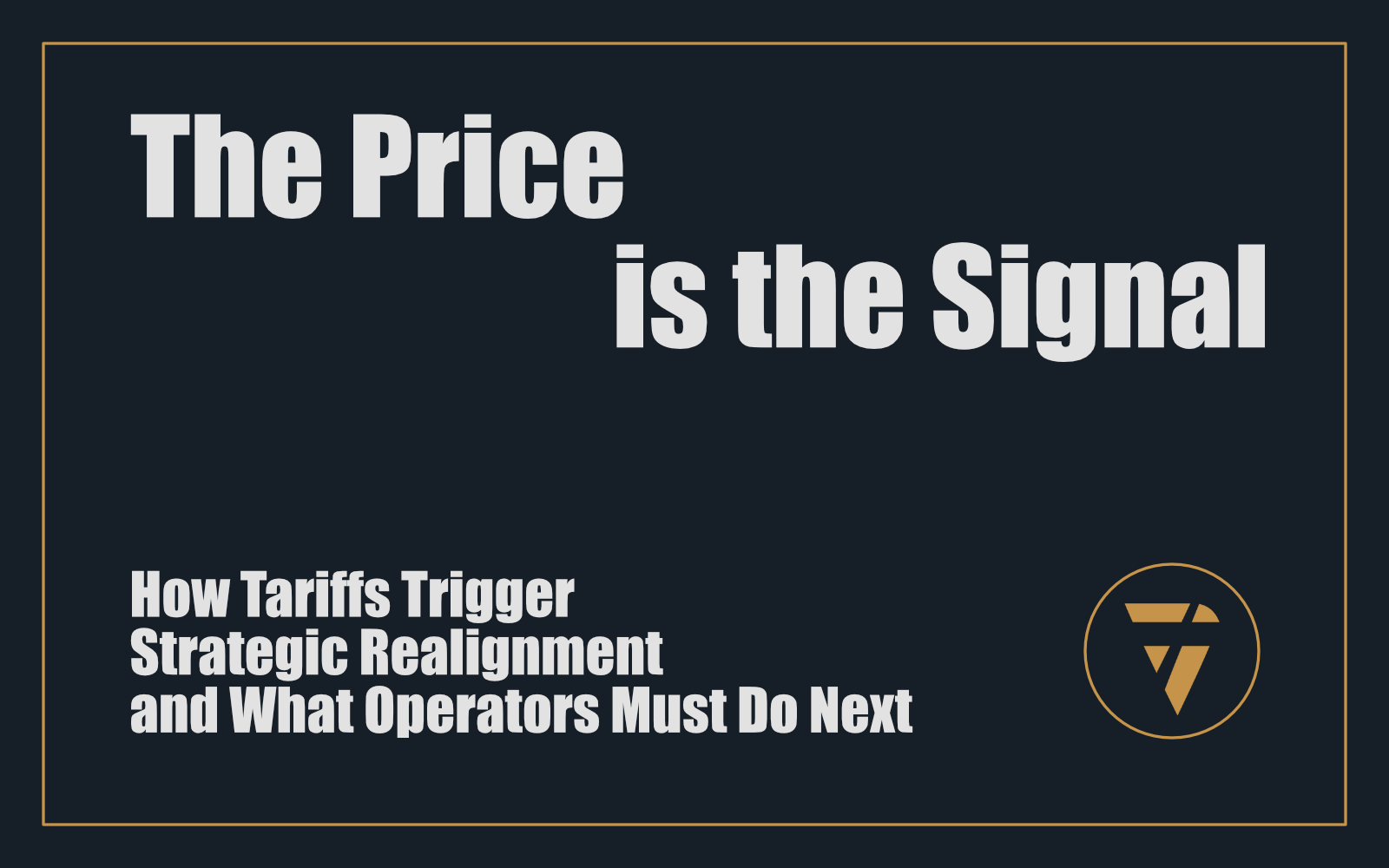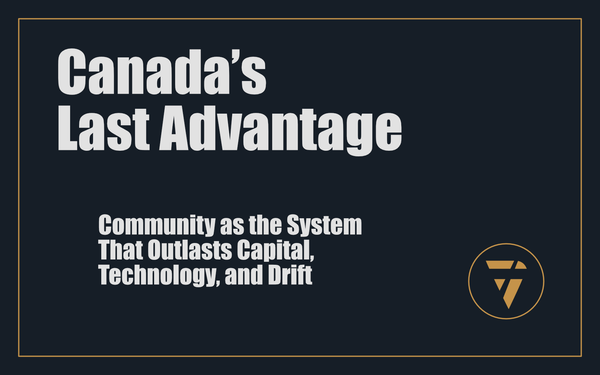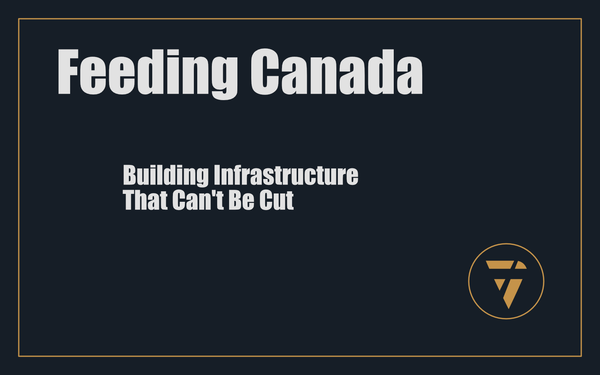The Price Is the Signal

How Tariffs Trigger Strategic Realignment and What Operators Must Do Next
In times of market friction, most companies retreat. The rest reposition.
Tariffs are not the problem... they are the diagnostic.
2025’s renewed wave of U.S. tariffs—100% on China, roughly 30% averaged across all imports for American consumers... or whatever they are at the time you read this—has created panic in boardrooms and confusion on the shop floor. But for the disciplined operator, this is not disruption. It’s a demand map.
When the price of supply shifts, your pricing no longer whispers... it screams. The only question is whether it says “panic” or “precision.”
Let’s anchor the truth. Tariffs create four immediate fractures:
- Cost distortions
- Inventory mismatches
- Elasticity misunderstandings
- Signal failure
Each one is a lever. If you don’t pull it, the market will pull you.
Tariff Shock Is the Pressure Test of Strategic Clarity
The Ford “employee pricing for all” play is not a sale—it’s a statement. Ferrari’s selective price hike is not luxury inflation—it’s demand filtration. BMW absorbing tariffs until May is not generosity—it’s loyalty insurance.
Each move, a calculated signal to their most elastic or inelastic buyers. Not one of these actions is reactive. They are demand architects using pricing as weaponry.
And yet, mid-market operators, e-commerce brands, software vendors, and manufacturers are standing still—waiting to see “what happens.”
Here’s what will happen:
If you do not realign pricing to elasticity in real time, you will get surplus, not scale. You will erode trust, not expand share. You will collapse leverage, not compound power.
So the game is not about tariffs. The game is about motion.
It's not often I read something that makes me sit back in my chair, smile, and then think about the mind that led to the words on the page.
Read Filippo:
Elasticity Is Not Just a Number—It’s Your Map to Strategic Motion
Elasticity tells you the cost of a mistake before you make it.
- If your buyer is elastic (–1.2 or more), a 10% price hike will drop demand by 12%.
- If inelastic (–0.5 to –1.0), you have pricing power—but only if signalled correctly.
This is not theory. It’s math with muscle.
Embed elasticity modelling inside real-time strategy arcs. Don’t price based on margin targets. Price to extract strategic advantage.
Let’s install this in your system.
Application Pathways: How To Use This Strategy Now
You’re not Ford. You’re not Ferrari. But you can run the same playbook, better. Here’s how.
1. E-Commerce: Tiered Elasticity Testing With Precision Pricing
Problem: 10% product cost increase due to tariffs. Confusion on where to raise, freeze, or discount.
Proconsul Deployment:
- Deploy a 3-tier price ladder on top 10% revenue products
- Estimate elasticity from past data or industry benchmarks
- Run simulations for each tier: revenue-maximizing, profit-maximizing, and defence-based
- Flash test new tiers via segmented email campaigns or retargeting ads
Consequence: Real-time demand clarity. Prevent surplus before it starts.
2. Manufacturing: Price-to-Volume Modelling Across Distribution
Problem: Retail partners panic. Tariff hits erode margins across the board.
Proconsul Deployment:
- Use Proconsul’s Diagnostic Price Elasticity Modelling Toolkit
- Create distributor-facing pricing scenarios tied to volume commitments
- Use tiered incentives to reward movement and reduce long-tail inventory exposure
Consequence: Convert chaos into commitment. Price becomes a growth tool, not a shield.
3. SaaS/Subscription Businesses: Loyalty Lock-In Through Tariff Anchoring
Problem: Cost of international operations rising. Clients expect price hikes.
Proconsul Deployment:
- Freeze pricing for current clients and offer loyalty extensions
- Introduce limited-time “Tariff-Proof” plans with longer commitment windows
- Use customer elasticity data to create “switch cost” pricing
Consequence: Convert perceived instability into loyalty leverage. Retention rises even as costs rise.
4. Retail: Inventory Liquidity Without Discount Destruction
Problem: Panic discounting drains margin. Tariffs create inventory drag.
Proconsul Deployment:
- Integrate elasticity and sell-through data with price mapping
- Deploy a precision “Clear, Hold, Accelerate” framework:
- Clear: Price below cost for elastic SKUs to drive volume
- Hold: Freeze high-margin inelastic items
- Accelerate: Bundle or add urgency to mid-elasticity SKUs
Consequence: Inventory moves with intention. Profit per unit rises. Brand integrity holds.
Strategic Installation: Beyond Price, Into Position
What most will miss is this: tariffs don’t just hit margins. They reveal mindset.
If your pricing model is defensive, you’re waiting for permission.
If your elasticity data is ignored, you’re guessing.
If your price changes don’t signal strategy, you’ve already lost share.
Pricing is the most public piece of your strategy. It's your front line signal to customers, competitors, and the capital markets.
With Proconsul, this is not an analytics exercise. It's a leverage installation:
- Strategic pricing engines
- Elasticity simulations embedded in ERP logic
- Demand-responsive narrative controls
- Capital-protective scenario pathways
- Partner-tiered incentive ladders
You don’t just survive tariff shock. You dominate in its shadow.
Final Motion: Install This Now
You are not too late. But the window is narrow.
- Pull your last 90 days of sales data.
- Estimate elasticity across top SKUs or service tiers.
- Build three pricing scenarios: volume win, margin win, balance play.
- Choose your primary objective per segment.
- Deploy changes in real-time, not via committee.
If you can’t do that in five days, you don’t have a pricing strategy. You have a spreadsheet.
We fix that. We plug in. We operationalize elasticity into power.
This isn’t just about surviving tariffs.
This is about becoming the operator who signals clarity in a market still spinning in reaction.
Let’s move.
Send me your top 5 SKUs or services. I’ll tell you what the price should say next.
This is what I’m working on. Tell me what you think, I enjoy the conversation! Subscribe and follow the work in real time.
Thanks!
B

“They didn’t raise prices. They made a decision.”
Tariffs don’t cause chaos... leaders do.
If your pricing doesn’t signal strategy, it signals surrender.
PS -






